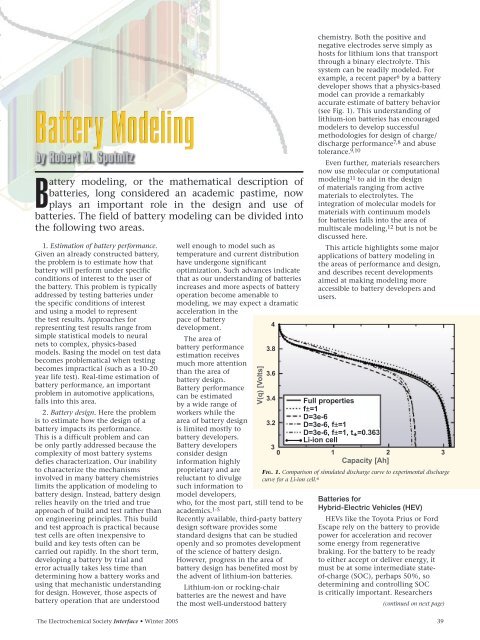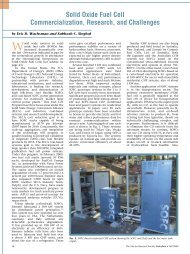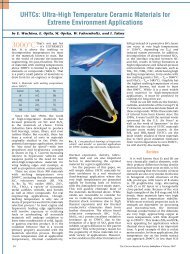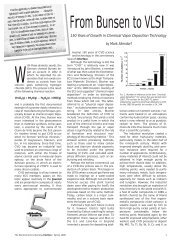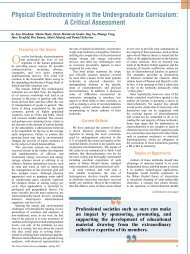Battery Modeling - The Electrochemical Society
Battery Modeling - The Electrochemical Society
Battery Modeling - The Electrochemical Society
Create successful ePaper yourself
Turn your PDF publications into a flip-book with our unique Google optimized e-Paper software.
<strong>Battery</strong> modeling, or the mathematical description of<br />
batteries, long considered an academic pastime, now<br />
plays an important role in the design and use of<br />
batteries. <strong>The</strong> field of battery modeling can be divided into<br />
the following two areas.<br />
1. Estimation of battery performance.<br />
Given an already constructed battery,<br />
the problem is to estimate how that<br />
battery will perform under specific<br />
conditions of interest to the user of<br />
the battery. This problem is typically<br />
addressed by testing batteries under<br />
the specific conditions of interest<br />
and using a model to represent<br />
the test results. Approaches for<br />
representing test results range from<br />
simple statistical models to neural<br />
nets to complex, physics-based<br />
models. Basing the model on test data<br />
becomes problematical when testing<br />
becomes impractical (such as a 10-20<br />
year life test). Real-time estimation of<br />
battery performance, an important<br />
problem in automotive applications,<br />
falls into this area.<br />
2. <strong>Battery</strong> design. Here the problem<br />
is to estimate how the design of a<br />
battery impacts its performance.<br />
This is a difficult problem and can<br />
be only partly addressed because the<br />
complexity of most battery systems<br />
defies characterization. Our inability<br />
to characterize the mechanisms<br />
involved in many battery chemistries<br />
limits the application of modeling to<br />
battery design. Instead, battery design<br />
relies heavily on the tried and true<br />
approach of build and test rather than<br />
on engineering principles. This build<br />
and test approach is practical because<br />
test cells are often inexpensive to<br />
build and key tests often can be<br />
carried out rapidly. In the short term,<br />
developing a battery by trial and<br />
error actually takes less time than<br />
determining how a battery works and<br />
using that mechanistic understanding<br />
for design. However, those aspects of<br />
battery operation that are understood<br />
well enough to model such as<br />
temperature and current distribution<br />
have undergone significant<br />
optimization. Such advances indicate<br />
that as our understanding of batteries<br />
increases and more aspects of battery<br />
operation become amenable to<br />
modeling, we may expect a dramatic<br />
acceleration in the<br />
pace of battery<br />
4<br />
development.<br />
<strong>The</strong> area of<br />
battery performance<br />
estimation receives<br />
much more attention<br />
than the area of<br />
battery design.<br />
<strong>Battery</strong> performance<br />
can be estimated<br />
by a wide range of<br />
workers while the<br />
area of battery design<br />
is limited mostly to<br />
battery developers.<br />
<strong>Battery</strong> developers<br />
consider design<br />
information highly<br />
proprietary and are<br />
reluctant to divulge<br />
such information to<br />
model developers,<br />
V(q) [Volts]<br />
3.8<br />
3.6<br />
who, for the most part, still tend to be<br />
academics. 1-5<br />
Recently available, third-party battery<br />
design software provides some<br />
standard designs that can be studied<br />
openly and so promotes development<br />
of the science of battery design.<br />
However, progress in the area of<br />
battery design has benefited most by<br />
the advent of lithium-ion batteries.<br />
Lithium-ion or rocking-chair<br />
batteries are the newest and have<br />
the most well-understood battery<br />
chemistry. Both the positive and<br />
negative electrodes serve simply as<br />
hosts for lithium ions that transport<br />
through a binary electrolyte. This<br />
system can be readily modeled. For<br />
example, a recent paper 6 by a battery<br />
developer shows that a physics-based<br />
model can provide a remarkably<br />
accurate estimate of battery behavior<br />
(see Fig. 1). This understanding of<br />
lithium-ion batteries has encouraged<br />
modelers to develop successful<br />
methodologies for design of charge/<br />
discharge performance 7,8 and abuse<br />
tolerance. 9,10<br />
Even further, materials researchers<br />
now use molecular or computational<br />
modeling 11 to aid in the design<br />
of materials ranging from active<br />
materials to electrolytes. <strong>The</strong><br />
integration of molecular models for<br />
materials with continuum models<br />
for batteries falls into the area of<br />
multiscale modeling, 12 but is not be<br />
discussed here.<br />
This article highlights some major<br />
applications of battery modeling in<br />
the areas of performance and design,<br />
and describes recent developments<br />
aimed at making modeling more<br />
accessible to battery developers and<br />
users.<br />
3.4 Full properties<br />
f±=1<br />
D=3e-6<br />
3.2 D=3e-6, f±=1<br />
D=3e-6, f±=1, t + =0.363<br />
Li-ion cell<br />
3<br />
0 1 2 3<br />
Capacity [Ah]<br />
FIG. 1. Comparison of simulated discharge curve to experimental discharge<br />
curve for a Li-ion cell. 6<br />
Batteries for<br />
Hybrid-Electric Vehicles (HEV)<br />
HEVs like the Toyota Prius or Ford<br />
Escape rely on the battery to provide<br />
power for acceleration and recover<br />
some energy from regenerative<br />
braking. For the battery to be ready<br />
to either accept or deliver energy, it<br />
must be at some intermediate stateof-charge<br />
(SOC), perhaps 50%, so<br />
determining and controlling SOC<br />
is critically important. Researchers<br />
(continued on next page)<br />
<strong>The</strong> <strong>Electrochemical</strong> <strong>Society</strong> Interface • Winter 2005 39
Spotnitz<br />
(continued from previous page)<br />
at GM have described a particularly<br />
elegant way for real-time SOC<br />
estimation. 13<br />
One may think that current<br />
integration will provide a good<br />
estimate of SOC. However, the nickel<br />
metal hydride (Ni/MH) batteries<br />
used in HEVs tend to lose charge<br />
during rest periods, and the current<br />
efficiency on charge can be less<br />
than 100%. To correct for these<br />
effects, the SOC may be estimated<br />
by dynamically fitting measured<br />
voltage and current data to a model.<br />
This model-based SOC estimate may<br />
be averaged with a SOC estimate<br />
obtained by current integration to<br />
give an accurate SOC estimate over<br />
a wide range of conditions. A side<br />
benefit of this approach is that one<br />
model parameter, a series resistance,<br />
gives an indication of the state-ofhealth<br />
of the battery.<br />
Another important aspect of<br />
HEV battery design is temperature<br />
uniformity. Nonuniform temperature<br />
distributions lead to shorter life<br />
because the hot areas wear out faster<br />
than the cool areas. HEV batteries<br />
typically consist of many cells in<br />
series. <strong>The</strong> current flows into each<br />
cell through a post and is then<br />
distributed along a grid or plate. This<br />
situation can cause the grid near<br />
the post to become much warmer<br />
than the grid furthest away from the<br />
post. Mathematical modeling work<br />
by Pesaran et al. 14 shows that the<br />
2001 model Ni/MH module in the<br />
Toyota Prius suffered from a nonuniform<br />
temperature distribution<br />
while the 2004 model, that used<br />
two connections for each grid,<br />
had a nearly uniform temperature<br />
distribution (Fig. 2). <strong>The</strong> model<br />
results were verified by thermal<br />
imaging experiments.<br />
FIG. 2. Computed temperature distributions for Ni/MH modules<br />
containing (a) one post for electrode and (b) two posts for each<br />
electrode. 14<br />
Batteries for Portable Computers<br />
As in HEVs, a uniform temperature<br />
distribution is important in battery<br />
packs for portable computers to<br />
provide long life. Maleki and<br />
Shamsuri 15 modeled the temperature<br />
distribution in a laptop computer<br />
battery pack (see Fig. 3). Interestingly,<br />
they found that the neighboring<br />
electronic circuit strongly influenced<br />
the temperature distribution. This<br />
analysis suggests that insulating<br />
the cells from the electronics may<br />
improve thermal uniformity.<br />
<strong>The</strong> problem of SOC estimation<br />
is also important in portable<br />
computers to give users an indication<br />
of available runtime. <strong>The</strong> usable<br />
capacity of a lithium-ion battery can<br />
be estimated using a simple model<br />
FIG. 3. Computed temperature distribution in a battery pack for portable computers. 15<br />
C<br />
R<br />
-<br />
+<br />
FIG. 4. Simple circuit model for lithium-ion battery.<br />
40 <strong>The</strong> <strong>Electrochemical</strong> <strong>Society</strong> Interface • Winter 2005
like that depicted in Fig. 4. <strong>The</strong> model<br />
involves two parameters: Ro and Vo.<br />
Vo is the open-circuit voltage of the<br />
battery and is an accurate indicator<br />
of SOC for lithium-ion batteries. Vo<br />
is determined when the battery is at<br />
rest and updated during charge or<br />
discharge of the battery by coulomb<br />
counting. Ro is the impedance of<br />
the battery and is dynamically<br />
obtained by real-time impedance<br />
measurements. For notebook<br />
computers, this approach appears to<br />
give remarkably accurate estimates of<br />
battery capacity and is used in a chip<br />
provided by Texas Instruments. 16<br />
Uninterruptible<br />
Power Supplies (UPS)<br />
Many businesses that rely on<br />
computers, such as stockbrokers,<br />
rely on UPS systems to avoid even<br />
momentary interruptions in electrical<br />
service. Assessing the state-of-health<br />
of UPS batteries is of great importance<br />
to such businesses. A promising<br />
model-based approach 17 involves<br />
use of a model that accounts for<br />
electrode kinetics, active surface area<br />
of the electrodes, liquid-phase mass<br />
transfer (concentration and potential<br />
gradients in solution), and solid-phase<br />
ohmic drops. Some key parameters<br />
(thickness of electrodes and separator,<br />
tortuosity of electrodes) for this<br />
complex model can be fit to an<br />
experimental charge/discharge curve.<br />
<strong>The</strong>n the calibrated simulation<br />
model may be used to estimate the<br />
capability of the battery to perform its<br />
UPS function. <strong>The</strong> model calibration<br />
procedure may be automated and<br />
carried out on a regular schedule so<br />
that the health of the battery may be<br />
monitored.<br />
<strong>The</strong> life of lead-acid batteries is<br />
often limited by corrosion of the<br />
positive grid. <strong>The</strong> lead grid is coated<br />
with positive active material (PAM).<br />
If the grid oxidizes, then there is<br />
less lead available to carry current<br />
and this may lead to eventual<br />
failure of the battery. Ball et al. 18<br />
provided insight into the problem<br />
by computing the current density<br />
distribution around a grid bar. <strong>The</strong>y<br />
correlated the computed current<br />
density with corrosion observed on<br />
a grid (Fig. 5). Areas of high current<br />
density corresponded to areas of high<br />
corrosion. This approach points the<br />
way to more corrosion-resistant grids<br />
and thus longer-life batteries.<br />
Aerospace Batteries<br />
In aerospace applications, batteries<br />
may sit for years before being used,<br />
so there is a need to estimate any<br />
detrimental effect aging has on<br />
battery capacity. Lithium-ion batteries<br />
undergo irreversible capacity loss<br />
when stored for long periods of<br />
time. At cell voltages below 4.0 V,<br />
the major source of capacity loss<br />
during storage is self-discharge of the<br />
negative electrode. Broussely 19 has<br />
used a film-growth model to describe<br />
this process successfully. <strong>The</strong> selfdischarge<br />
reaction produces a film<br />
that inhibits further self-discharge, so<br />
the process is self-limiting. <strong>The</strong> rate of<br />
film growth is inversely proportional<br />
to thickness (so grows according to<br />
the square root of time) and the rate<br />
constant follows Arrhenius behavior.<br />
Plots of irreversible capacity loss vs.<br />
the square root of time are linear, and<br />
the slopes of such plots obtained at<br />
temperatures below 50 o C follow an<br />
Arrhenius expression. This behavior<br />
provides confidence in extrapolating<br />
measurements made over 1-2 years to<br />
5-10 years.<br />
Software for <strong>Battery</strong> <strong>Modeling</strong><br />
Professor John Newman provides<br />
a model for lithium and lithiumion<br />
batteries on his website. 20 Most<br />
battery modeling is carried out<br />
using general-purpose tools such as<br />
MATLAB ® and ANSYS ® . However,<br />
the growing importance of battery<br />
modeling has led to the development<br />
of customized software. <strong>The</strong> most<br />
FIG. 5. Computed current distribution on lead-acid battery grid and electron micrograph cross section of actual grid. 18<br />
comprehensive approach to battery<br />
design and simulation is provided by<br />
the <strong>Battery</strong> Design Studio ® software<br />
offered by <strong>Battery</strong> Design. 21 <strong>The</strong><br />
software is primarily a user interface<br />
for accessing battery models, and<br />
provides a user friendly environment<br />
for battery design and simulation<br />
as well as analysis of battery data.<br />
<strong>The</strong> software includes sizing<br />
routines for various cell geometries<br />
(stacked or spirally wound), models<br />
for simulating battery behavior,<br />
including abuse, a database, and tools<br />
for visualizing and analyzing battery<br />
data. <strong>The</strong>se features constitute a<br />
standardized means to communicate<br />
battery information (designs, data,<br />
and models) among interested parties.<br />
<strong>The</strong> capability to communicate<br />
battery information easily using<br />
software makes modeling more<br />
accessible to battery developers,<br />
and makes battery design and<br />
performance information more<br />
accessible to modelers. By facilitating<br />
comparisons between model<br />
predictions and data, such software<br />
brings the full force of the scientific<br />
method to bear on the problem of<br />
battery design.<br />
Final Remarks<br />
Mathematical modeling is<br />
firmly entrenched for estimating<br />
battery performance as evidenced<br />
by the applications discussed<br />
above. Mathematical modeling is<br />
only beginning to impact battery<br />
development. <strong>The</strong> overwhelming<br />
complexity of battery systems<br />
encourages battery developers to<br />
focus their resources on building<br />
and testing batteries rather than<br />
developing mathematical models.<br />
However, modeling is now more<br />
accessible to battery developers<br />
thanks to third-party software.<br />
<strong>Battery</strong> developers should strive<br />
to make battery design part of the<br />
design process of battery-powered<br />
products.<br />
Low<br />
Current<br />
Denisty<br />
High<br />
Current<br />
Denisty<br />
To paraphrase a<br />
recent statement,<br />
“You go to production<br />
with the battery you<br />
have, not the battery<br />
you want.” Producers<br />
of battery-powered<br />
devices must use<br />
whatever batteries<br />
are available in their<br />
products because<br />
designing a custom<br />
battery takes too long.<br />
Reducing the design<br />
cycle of a battery from<br />
years to months will<br />
(continued on next page)<br />
<strong>The</strong> <strong>Electrochemical</strong> <strong>Society</strong> Interface • Winter 2005 41
Spotnitz<br />
(continued from previous page)<br />
enable customization of batteries for<br />
individual products, making batterypowered<br />
products more useful and<br />
batteries more valuable. <strong>Modeling</strong><br />
is the most proven method for<br />
shortening design cycles. Making<br />
battery modeling an integral part<br />
of the battery design process is the<br />
battery industry’s biggest challenge. •<br />
References<br />
1. T. F. Fuller, M. Doyle, and J. Newman,<br />
J. Electrochem. Soc., 141, 1 (1994).<br />
2. D. Fan and R. White, J. Electrochem. Soc.,<br />
138, 18 (1991).<br />
3. C. Y. Mak, H. Y. Cheh, G. S. Kelsey, and<br />
P. Chalilpoyil, J. Electrochem. Soc., 138,<br />
1607 (1991).<br />
4. C. Y. Wang, W. B. Gu, and B. Y. Liaw,<br />
J. Electrochem. Soc., 145, 3407 (1998).<br />
5. N. Harb and R. M LaFollette, J.<br />
Electrochem. Soc., 146, 809 (1999).<br />
6. L. O. Valøen and J. N. Reimers,<br />
J. Electrochem. Soc., 152, A882 (2005).<br />
7. T. F. Fuller, M. Doyle, and J. Newman,<br />
J. Electrochem. Soc., 141, 982 (1994).<br />
8. M. Doyle and Y. Fuentes, J. Electrochem.<br />
Soc., 150, A706 (2003).<br />
9. T. D. Hatchard, D. D. MacNeil, A. Basu,<br />
and J. R. Dahn, J. Electrochem. Soc., 148,<br />
A755 (2001).<br />
10. E. Roth, D. Doughty, and R. M. Spotnitz,<br />
Paper 1302 presented at the Quebec City,<br />
Canada, Meeting of <strong>The</strong> <strong>Electrochemical</strong><br />
<strong>Society</strong>, May 15-20, 2005.<br />
11. G. Cedar, M. Doyle, P. Arora, and Y.<br />
Fuentes, MRS Bull., 27, 619 (2002).<br />
12. See papers from symposium on Multiscale<br />
Simulations of <strong>Electrochemical</strong> Systems,<br />
presented at <strong>The</strong> <strong>Electrochemical</strong> <strong>Society</strong><br />
Meeting, Los Angeles, CA, Oct. 16-21,<br />
2005.<br />
13. M. Verbrugge and E. Tate, J. Power Sources,<br />
126, 236 (2004).<br />
14. A. Pesaran, A. Vlahinos, D. Bharathan,<br />
G.-H. Kim, and T. Duong, Paper presented<br />
at 21st Electric Vehicle Symposium,<br />
Monaco, April 4-7, 2005.<br />
15. H. Maleki and A. K. Shamsuri, J. Power<br />
Sources, 115, 131 (2003).<br />
16. Y. Barsukov, in Advances In <strong>Battery</strong><br />
Charging, Monitoring, and Testing, August<br />
19, 2004, Conference Proceedings,<br />
Denver, CO.<br />
17. A. Tenno, R. Tenno, and T. Suntio,<br />
J. Power Sources, 103, 42 (2001); A. Tenno,<br />
R. Tenno, and T. Suntio, J. Power Sources,<br />
111, 65 (2002).<br />
18. R. J. Ball, R. Evans, and R. Stevens, J. Power<br />
Sources, 103, 213 (2002).<br />
19. M. Broussely, in Advances in Lithium-Ion<br />
Batteries, W. A. van Schalkwijk and B.<br />
Scrosati, Editors, Kluwer Academic/<br />
Plenum, New York (2002).<br />
20. http://www.cchem.berkeley.edu/~jsngrp/<br />
fortran.html<br />
21. http://www.batdesign.com/<br />
About the Author<br />
ROBERT SPOTNITZ is President of <strong>Battery</strong><br />
Design LLC in Pleasanton, California where<br />
he develops software for battery design and<br />
simulation. He teaches short courses on<br />
battery design for ECS and the Advanced<br />
Automotive <strong>Battery</strong> Conference. He can be<br />
reached at rspotnitz@batdesign.com.<br />
42 <strong>The</strong> <strong>Electrochemical</strong> <strong>Society</strong> Interface • Winter 2005


